
Conversational marketing is rapidly becoming a must-have for companies looking to stay ahead of the competition. This innovative approach signals a shift from traditional marketing norms. Unlike one-way communication, it fosters dynamic, two-way customer interactions, creating a more engaging and personalized experience.
Let’s examine why it works so well for sparking conversation and how you can easily implement it in your business.
What is conversational marketing?
Conversational marketing is a means of facilitating human-like conversations with the use of chat widgets, voice assistants, and messaging apps to interact with customers and prospects in real-time.
The personalized communications you can generate using conversational marketing help build deeper consumer relationships and provide a seamless customer experience.
It is a quick and convenient way to interact with customers and offers many benefits for businesses, including increased engagement, improved customer satisfaction, higher conversion rates, and reduced operational costs.
How does conversational marketing work?
The integration of conversational marketing doesn’t call for a radical transformation. Instead, it’s comparable to activating a supplementary lead generation channel that aligns with the current marketing strategies.
Simplified within the conversational framework, the following steps follow a clear and straightforward progression:
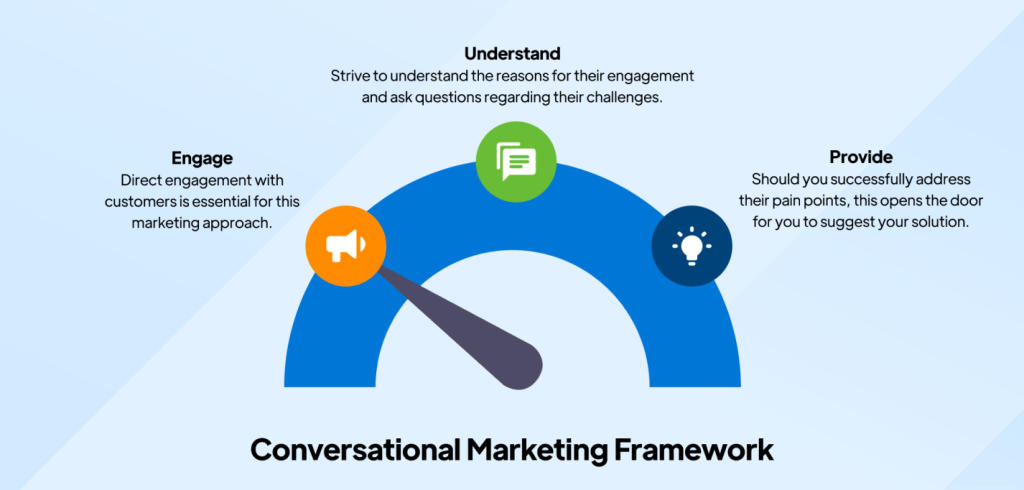
Engage
Initiating conversations forms the core of conversational marketing. It’s about creating a dynamic and responsive communication channel, akin to opening a two-way street for connection and accessibility.
Understand
The next step involves actively comprehending customer needs. Conversational marketing goes beyond surface-level exchanges. It dives into understanding the nuances of customer expectations and concerns.
Provide
This preference for messaging channels speaks to the desire for instant, convenient, and personalized interactions. Conversational marketing capitalizes on this trend, offering customers a direct and responsive avenue to gather information, seek assistance, and make informed decisions.
Benefits of leveraging conversational marketing for business
Here are some of the benefits conversational marketing can bring to your business.
Increased customer engagement
Conversational marketing creates a personalized and responsive interaction space.
TechCrunch is a noteworthy example of effective chatbot integration for its operations. Through its chatbot functionality, users have the flexibility to access timely and relevant content at their convenience. Users can also customize their experience by specifying the frequency and type of fresh content they desire to receive.
Real-time interactions and problem resolution
Real-time interactions through conversational marketing are instrumental in swift problem resolution.
Slack, a popular collaboration platform, employs real-time chat for customer support. This has resulted in a notable reduction in issue resolution time, allowing businesses to address challenges promptly.
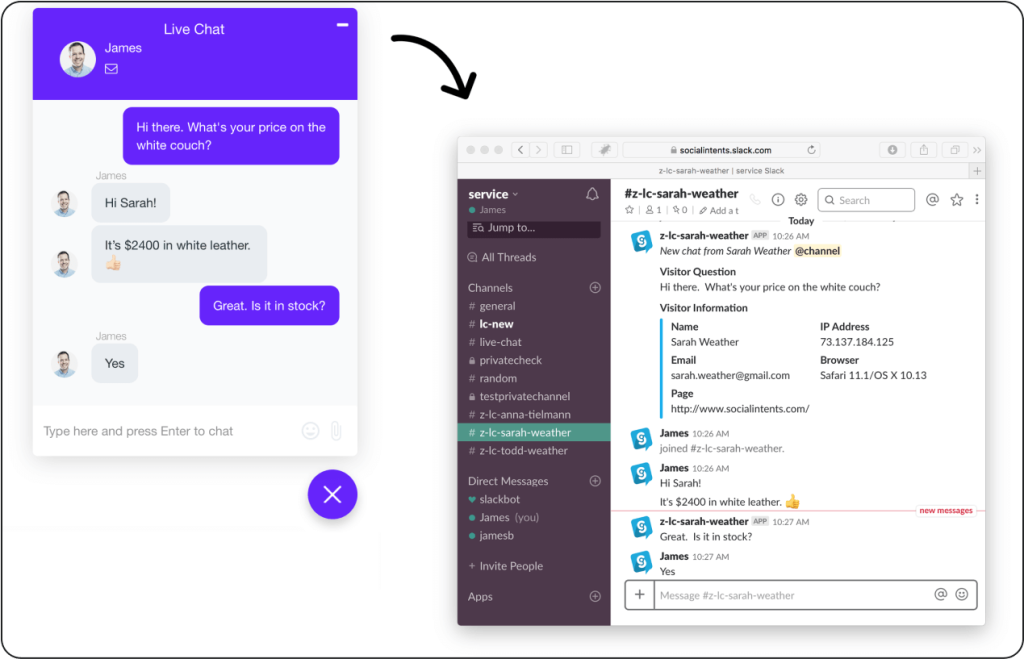
Reduced operational costs
Automated chatbots, for instance, can handle routine queries, reducing the workload on customer support teams. A Tidio.com research found that chatbots can save businesses up to 30% on customer support costs alone
Higher conversion rates
By facilitating real-time, personalized customer interactions, conversational marketing creates a more engaging and trust-building experience that significantly enhances the likelihood of conversions.
Belgian insurance bank Belfius aimed to enhance efficiency and reduce employee burden. By implementing Chatlayer’s artificial intelligence (AI) bot, customers can now easily communicate their claims, allowing the bot to streamline the process. This innovation has significantly improved the conversion rate by 87% compared to the traditional claim forms.
A better understanding of customer needs and preferences
Leading brands strategically implement conversational marketing for improved insights into customer requirements and expectations.
Oracle deploys chatbots for personalized customer inquiries by adapting services to individual needs.
Ability to scale customer interactions effectively
Businesses can effectively navigate fluctuating customer interactions with conversational marketing.
Salesforce, a key player in business-to-business (B2B) customer relationship management (CRM) solutions, effectively scales customer engagement using AI-driven chat. This allowed them to manage the increase in user interactions during peak periods, showing the adaptability of conversational marketing in meeting fluctuating demands.
Increased customer loyalty and retention
In B2B relationships, fostering customer loyalty is instrumental for long-term partnerships.
Microsoft employs conversational marketing through personalized communication channels. By offering exclusive insights, support, and tailored recommendations, Microsoft has increased customer loyalty and retention.
Personalized customer experiences
Tailoring interactions to individual preferences, conversational marketing reshapes and enhances customer experiences.
Erica, Bank of America’s virtual assistant, delivers individualized financial guidance to users. Utilizing natural language processing (NLP), the chatbot comprehends user queries and offers assistance. Erica assists users with tasks such as bank account management, expense tracking, bill payments, etc.
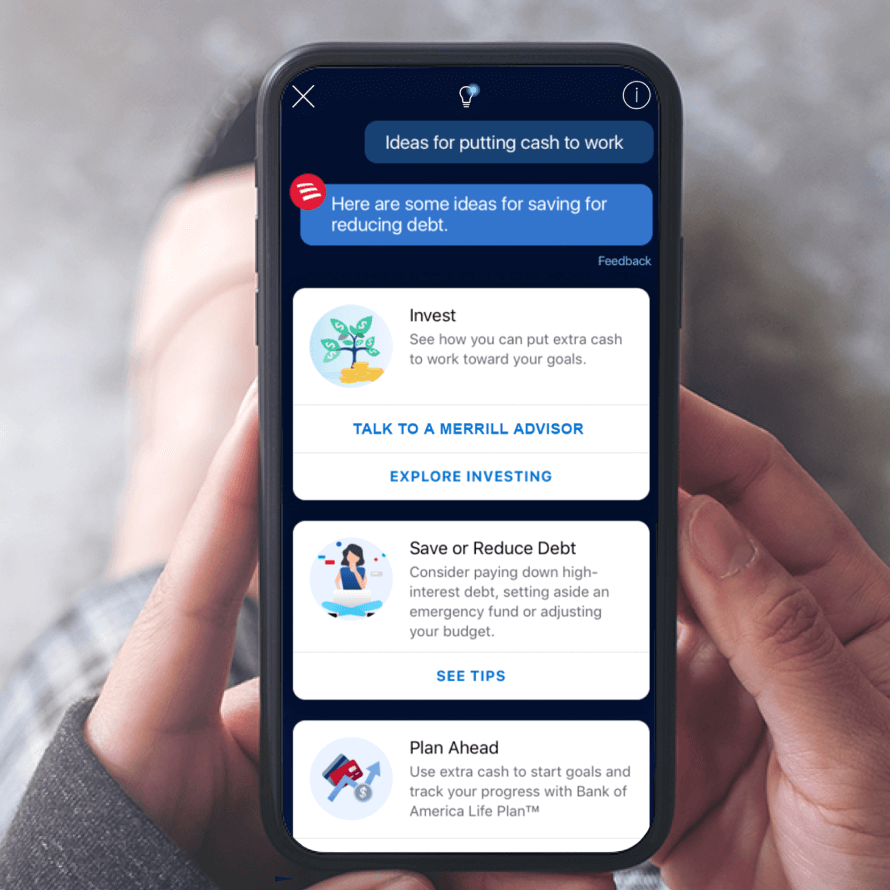
Create a conversational marketing strategy
Creating a conversational marketing strategy is an iterative process. As your clients’ preferences shift, so will your strategy. We have devised a fixed structure you can work on and modify as you go.
1. Define your business goals and metrics
Identifying clear business goals and metrics is key to a successful conversational marketing strategy. Begin by pinpointing the following.
- The overall business strategy: Ensure that your defined goals align seamlessly with your broader business strategy. This alignment establishes a cohesive and purposeful direction for your conversational marketing efforts.
- Measurable objectives: Select measurable objectives that allow for tangible assessment. Prioritize objectives with clear metrics, whether quantifying lead generation, tracking conversion rates, or evaluating customer satisfaction.
- Timelines and milestones: Establish realistic timelines and milestones for achieving your goals. Breaking down larger objectives into manageable steps with clear deadlines provides a structured approach.
2. Understand customer behavior
Customer behavior is the entry gate to successful conversational marketing. Here, you’ll find all the info you need on your target audience, what pushes them along the sales funnel, and what ultimately closes the sale. To get a complete grasp of customer behavior, you need to look into the following aspects.
- Customer personas: Use analytics and social listening to understand demographics and behavior.
- The customer journey: Identify and analyze touchpoints for tailored messaging.
- Pain points: Identify customer challenges through support interactions and sentiment analysis.
- Preferences: Learn communication preferences from past customer interactions and A/B testing.
3. Choose the right channels
Choosing the right channels for conversational marketing involves considering various factors such as target audience, budget, company goals, and customer behavior. Here are some of the most effective channels we’ve come across.
- Chatbots: Automate routine queries to free up agents for complex issues. For example, H&M uses chatbots to assist with product issues and order processing.
- Social media: Engage customers directly on platforms like Facebook and X. Uber uses X to handle customer support inquiries and resolve issues seconds after they’ve been signaled.
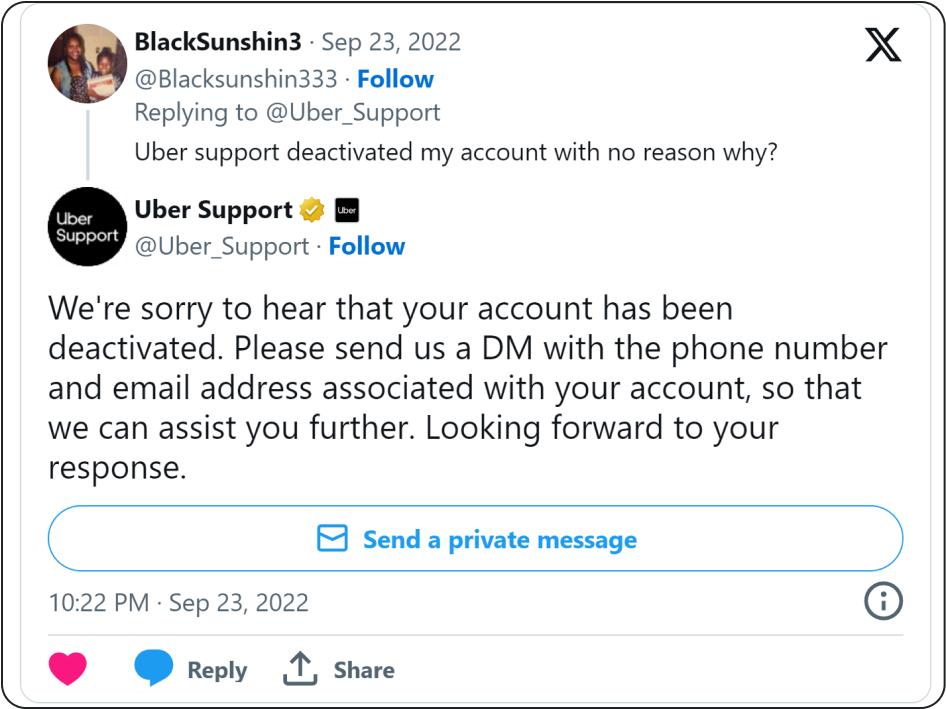
- Voice assistants: Brands use tools like Amazon Alexa or Google Assistant for hands-free, voice-activated customer interactions. For instance, Starbucks allows customers to order their favorite drinks using Alexa.
- Video calls: Ideal for personalized support and building trust. Telstra, an Australian telecommunications company, provides technical support and troubleshoots customer issues using video calls.
- SMS/texting: A personal and direct channel that allows immediate two-way communication. Sephora uses SMS to send personalized beauty recommendations and promotions to its customers.
4. Combine with other marketing efforts
To create a comprehensive and cohesive customer experience, you need to sync conversational marketing with other marketing strategies. Here are some examples of how companies have successfully achieved that.
- Content marketing: Companies can provide a more interactive and engaging experience for customers when they integrate chatbots into their content. American Express uses this technique to provide financial advice and recommendations within its educational content.
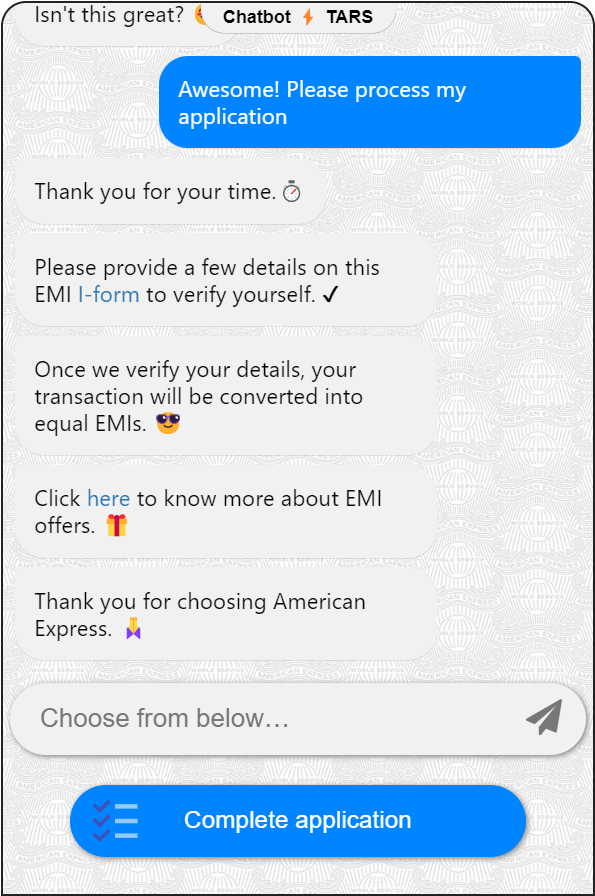
- Event marketing: By integrating chatbots and live chat into events, companies can provide a personalized experience for event participants and respond to their questions and concerns on the spot. Nike uses chatbots and live chat at sporting events to answer questions about products and provide customer support.
- Influencer marketing: L’Oreal uses chatbots and live chat in its influencer marketing campaigns to provide skin-care advice and customer recommendations. This leads to increased customer loyalty and brand awareness.
5. Personalize conversations to create human-like experiences
Personalization is a key aspect of conversational marketing and can be achieved by implementing the following strategies.
- Segmentation: Tailor conversations to specific audience groups for higher engagement.
- Dynamic content: Use AI for personalized, situation-responsive messages.
- Contextual awareness: Chatbots track conversation context for relevance.
- Predictive analytics: Data-driven predictions for personalized recommendations.
- Human override: Option for human assistance in complex situations.
6. Access the right tools
A company needs the following tools to successfully create and implement a conversational marketing strategy.
- Chatbot platforms: Build and manage chatbots (e.g., MobileMonkey, Tars).
- AI and NLP technology: For intelligent, conversational responses (e.g., IBM Watson).
- CRM systems: Manage customer data and insights (e.g., Salesforce).
- Analytics tools: Evaluate marketing efforts (e.g., Google Analytics).
- Live chat software: Real-time support (e.g., Zendesk Chat).
- Integrations and application programming interfaces: Connect with other marketing data tools/sales technologies.
Four effective conversational marketing examples
Next, we’ll explore some successful examples of conversational marketing, showcasing how dynamic and personalized communication can significantly enhance customer engagement.
UNIQLO
Japanese clothing retail company UNIQLO strategically employs conversational marketing with its chatbot, emphasizing the brand’s dedication to delivering personalized, engaging, and user-friendly interactions. Beyond online browsing, the chatbot offers practical features like a store locator, allowing customers to find nearby stores effortlessly.
Also, including information about returns showcases the comprehensive support for the customer journey.
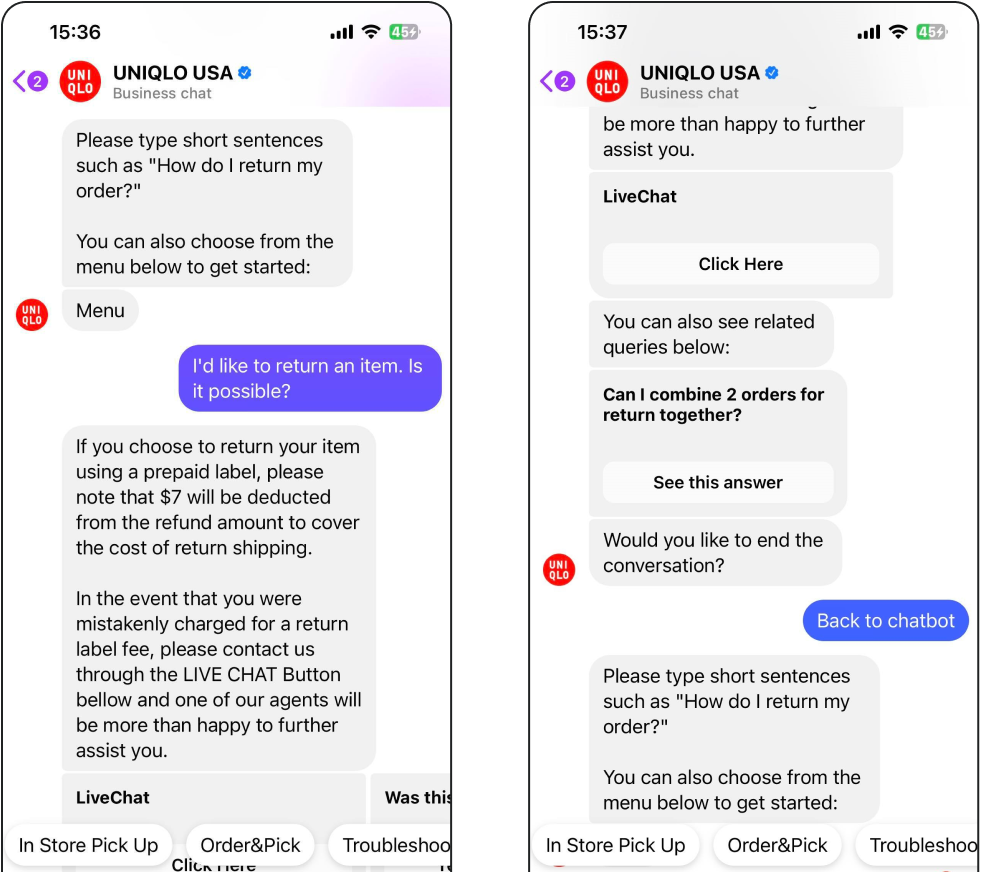
H&M
Fast-fashion retailer H&M is another example of how well conversational marketing works, especially for retail companies. Their “HM Service Bot” provides customers with real-time support, including product recommendations, order tracking, and customer service.
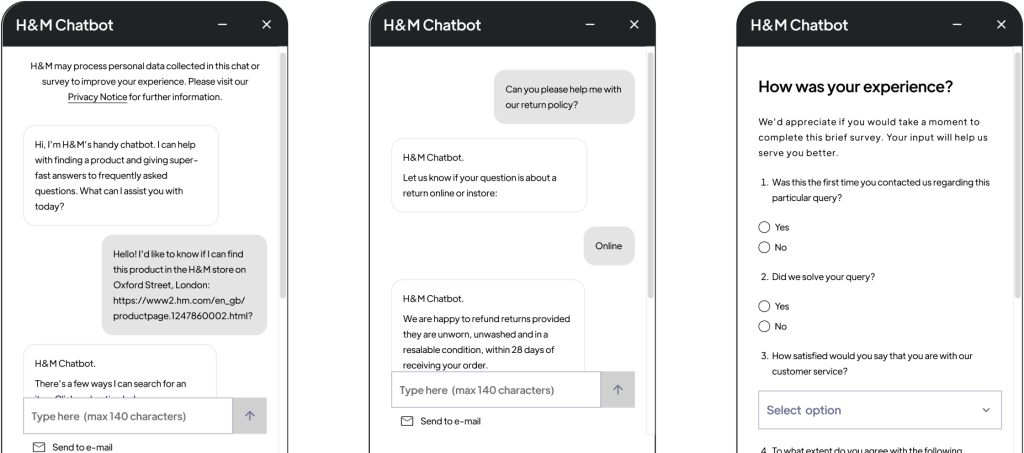
Domino’s Pizza
SMS proves to be a convenient marketing channel, offering benefits to both customers and brands. To illustrate this, Domino’s Pizza introduced its AnyWare initiative, allowing customers to order through channels such as SMS with Apple Carplay, Alexa, or Apple Watch. Through this innovative approach, customers can simply send an 🍕 emoji to order their preferred pizza after setting up their default choice.
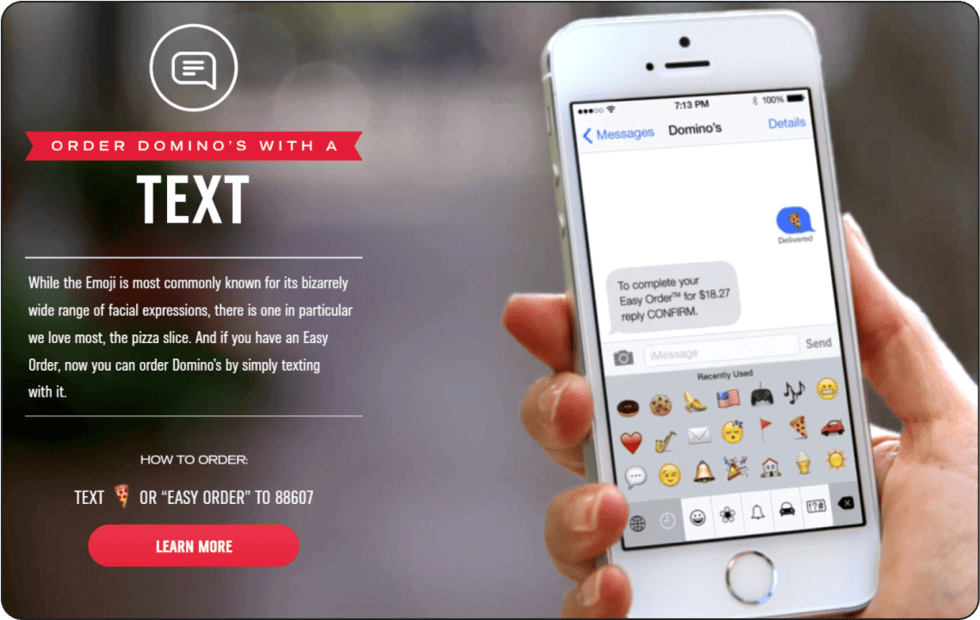
Umzu
The way Umzu employs conversational commerce stands out as a compelling example. Their chosen method involves a quiz, where users engage by answering basic questions, leading to the revelation of products tailored to their needs.
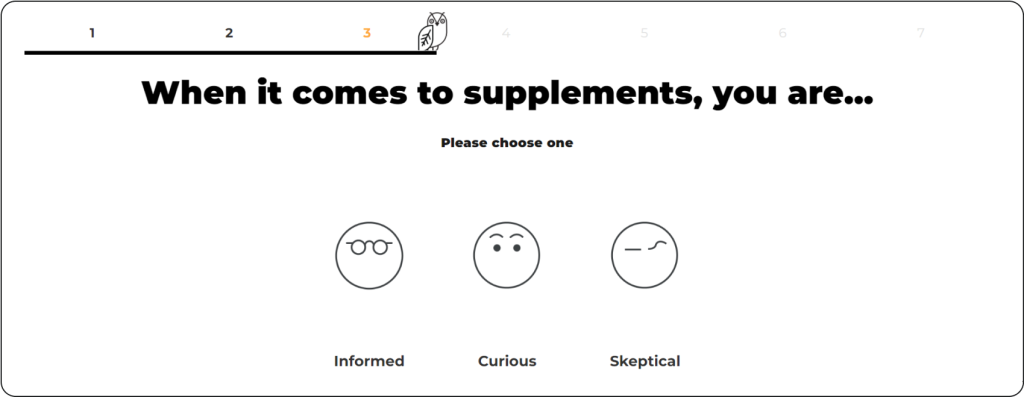
Framebridge
A less-known example of conversational marketing done right is brought to you by Framebridge. The online custom framing company enabled a live chat feature that allows customers to chat with a company rep in real time. This type of support is personalized and offers quick response times, which the clients appreciated because it led to a standout customer experience.
The examples we listed above are just a small proof of what conversational marketing can do for any business, regardless of profile, size, or years on the market. It is, by far, the easiest way to provide excellent customer support in any situation, with reduced costs.

Conclusion
Conversational marketing is a game-changer for companies looking to boost their customer engagement and build a more personal relationship with their audience.
Not only does it provide a more personalized experience, but it also offers extensive data on how to improve customer satisfaction and drive business results. In an era when competition is fierce and attention is hard to come by, companies that adopt conversational marketing hold the competitive edge.
Stay tuned to our blog for more tips on how to improve your customer communication!
Frequently Asked Questions (FAQs)
Dialogue-oriented marketing creates ongoing two-way conversations that gather customer insights while delivering value.
This can happen through polls, chatbots, social media questions, or customer support interactions, all aimed at deepening the connection between your brand and audience.
Yes, it’s flexible enough for both.
A skincare brand might use Messenger to ask about skin type and recommend products on the spot. Meanwhile, a B2B cybersecurity firm might use a chatbot to book consultations after answering technical questions.
It’s the interaction that matters, not the business type.
From chatbots and social media DMs to voice assistants, conversational marketing uses various platforms to connect with customers naturally.
Textmagic fits in as a multi-channel tool that helps you converse with customers who prefer text messaging or email.
Conversational AI solutions like Drift, Intercom, or Zendesk Answer Bot are designed to integrate with CRM and marketing ecosystems.
These platforms integrate with CRMs such as Salesforce and HubSpot, as well as marketing tools like Marketo and Mailchimp.
Related articles
7 Mobile marketing best practices for small businesses
Mobile marketing is by far the best strategy you cou...
Top 10 must-attend customer experience conferences in 2025
Customer experience conferences are remarkable hubs ...
Top 20 best marketing automation tools to use in 2025
Explore the best marketing automation tools, with de...
Unleashing the power of loyalty: 12 Inspiring loyalty program examples and solutions
Ever notice how customers keep coming back to their ...
Workplace collaboration: Our secrets to more productive teams
Seamless collaboration in the workplace is a game-ch...




